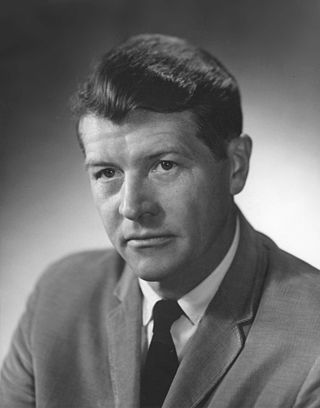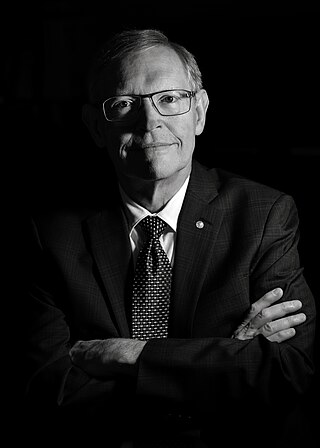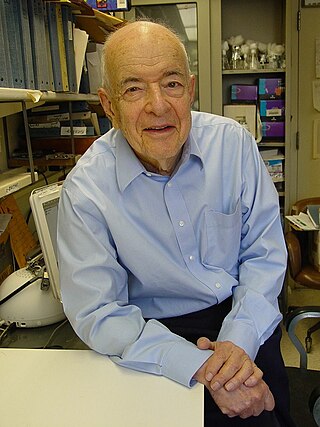
Christian Boehmer Anfinsen Jr. was an American biochemist. He shared the 1972 Nobel Prize in Chemistry with Stanford Moore and William Howard Stein for work on ribonuclease, especially concerning the connection between the amino acid sequence and the biologically active conformation.

Carlos José Bustamante is a Peruvian-American scientist. He is a member of the National Academy of Sciences.

Martin Karplus is an Austrian and American theoretical chemist. He is the Director of the Biophysical Chemistry Laboratory, a joint laboratory between the French National Center for Scientific Research and the University of Strasbourg, France. He is also the Theodore William Richards Professor of Chemistry, emeritus at Harvard University. Karplus received the 2013 Nobel Prize in Chemistry, together with Michael Levitt and Arieh Warshel, for "the development of multiscale models for complex chemical systems".

William Esco Moerner, also known as W. E. Moerner, is an American physical chemist and chemical physicist with current work in the biophysics and imaging of single molecules. He is credited with achieving the first optical detection and spectroscopy of a single molecule in condensed phases, along with his postdoc, Lothar Kador. Optical study of single molecules has subsequently become a widely used single-molecule experiment in chemistry, physics and biology. In 2014, he was awarded the Nobel Prize in Chemistry.
Watt Wetmore Webb was an American biophysicist, known for his co-invention of multiphoton microscopy in 1990.

John Kuriyan is the dean of basic sciences and a professor of biochemistry at Vanderbilt University School of Medicine. He was formerly the Chancellor's Professor at the University of California, Berkeley in the departments of molecular and cell biology (MCB) and chemistry, a faculty scientist in Berkeley Lab's physical biosciences division, and a Howard Hughes Medical Institute investigator. He is a member of the National Academy of Sciences and he has also been on the Life Sciences jury for the Infosys Prize in 2009, 2019 and 2020.
William Dale Phillips was an American chemist, nuclear magnetic resonance spectroscopist, federal science policy advisor and member of the National Academy of Sciences. He was born October 10, 1925, in Kansas City, Missouri and died in St. Louis, Missouri, on December 15, 1993.
Mitchell Lazar is an endocrinologist and physician-scientist known for his discovery of the hormone resistin and his contributions to the transcriptional regulation of metabolism.

Martin Gruebele is a German-born American physical chemist and biophysicist who is currently James R. Eiszner Professor of Chemistry, Professor of Physics, Professor of Biophysics and Computational Biology at the University of Illinois Urbana-Champaign, where he is the principal investigator of the Gruebele Group.

Peter Guy Wolynes is an American theoretical chemist and physicist. Since 2011 he has been a Bullard-Welch Foundation Professor of Science and professor of chemistry at Rice University. He is widely recognized for his significant contributions to the theories of protein folding, glasses, and gene networks. Previously he was James R. Eiszner Professor at the University of Illinois at Urbana-Champaign, and the Francis H.C. Crick Chair of Physical Sciences at the University of California, San Diego.
Michael F. Brown is an American chemist. Since 1987, he has been a Professor of Chemistry at the University of Arizona, and since 2003 has held joint appointments as a Professor of Physics and Professor of Applied Mathematics. Prior to the University of Arizona, Brown earned tenure at the University of Virginia. His research involves the application of NMR spectroscopy and other biophysical methods to study membrane lipids, liquid crystals, and membrane proteins. Brown has particularly been a pioneer in the application of solid-state NMR spectroscopy to the study of lipid bilayer dynamics.
The National Institute of Diabetes and Digestive and Kidney Diseases (NIDDK) is part of the United States National Institutes of Health, which in turn is part of the Department of Health and Human Services. NIDDK is approximately the fifth-largest of the 27 NIH institutes. The institute's mission is to support research, training, and communication with the public in the topic areas of "diabetes and other endocrine and metabolic diseases; digestive diseases, nutritional disorders, and obesity; and kidney, urologic, and hematologic diseases". As of 2021, the Director of the institute is Griffin P. Rodgers, who assumed the position on an acting basis in 2006 and on a permanent basis in 2007.
Robert Tycko is an American biophysicist whose research primarily involves solid state NMR, including the development of new methods and applications to various areas of physics, chemistry, and biology. He is a member of the Laboratory of Chemical Physics in the National Institute of Diabetes and Digestive and Kidney Diseases at the National Institutes of Health in Bethesda, Maryland, USA. He was formerly a member of the Physical Chemistry Research and Materials Chemistry Research departments of AT&T Bell Labs in Murray Hill, New Jersey. His work has contributed to our understanding of geometric phases in spectroscopy, physical properties of fullerenes, skyrmions in 2D electron systems, protein folding, and amyloid fibrils associated with Alzheimer’s disease and prions.
Robert Walter Zwanzig was an American theoretical physicist and chemist who made important contributions to the statistical mechanics of irreversible processes, protein folding, and the theory of liquids and gases.

G. Marius Clore MAE, FRSC, FMedSci, FRS is a British-born, Anglo-American molecular biophysicist and structural biologist. He was born in London, U.K. and is a dual U.S./U.K. Citizen. He is a Member of the National Academy of Sciences, a Fellow of the Royal Society, a Fellow of the Academy of Medical Sciences, a Fellow of the American Academy of Arts and Sciences, a NIH Distinguished Investigator, and the Chief of the Molecular and Structural Biophysics Section in the Laboratory of Chemical Physics of the National Institute of Diabetes and Digestive and Kidney Diseases at the U.S. National Institutes of Health. He is known for his foundational work in three-dimensional protein and nucleic acid structure determination by biomolecular NMR spectroscopy, for advancing experimental approaches to the study of large macromolecules and their complexes by NMR, and for developing NMR-based methods to study rare conformational states in protein-nucleic acid and protein-protein recognition. Clore's discovery of previously undetectable, functionally significant, rare transient states of macromolecules has yielded fundamental new insights into the mechanisms of important biological processes, and in particular the significance of weak interactions and the mechanisms whereby the opposing constraints of speed and specificity are optimized. Further, Clore's work opens up a new era of pharmacology and drug design as it is now possible to target structures and conformations that have been heretofore unseen.

Kalman Laki, sometimes referred to as Koloman Laki, was a Hungarian-American biochemist who contributed to the discovery of factor XIII. He was a scientist at the US National Institutes of Health (NIH).
Attila Szabo is a biophysicist who is a Distinguished Investigator and Section Chief of the Theoretical Biophysical Chemistry Section in the Laboratory of Chemical Physics at the National Institute of Diabetes and Digestive and Kidney Diseases, part of the United States National Institutes of Health.

Roberta F. Colman, born Roberta Fishman, was an American biochemist.

Carole Ann Bewley is an American chemist. She is a senior investigator and Chief of the Laboratory of Bioorganic Chemistry at the United States National Institute of Diabetes and Digestive and Kidney Diseases. Bewley researches secondary metabolites and basic principles involved in protein-carbohydrate interactions and how these can be exploited to engineer therapeutics.

Herbert Tabor was an American biochemist and physician-scientist who specialized in the function of polyamines and their role in human health and disease. Tabor was a principal investigator at the National Institute of Diabetes and Digestive and Kidney Diseases where he was Chief of the Laboratory of Biochemical Pharmacology. He was the editor-in-chief of the Journal of Biological Chemistry from 1971 to 2010.












